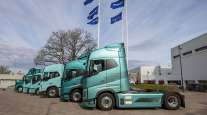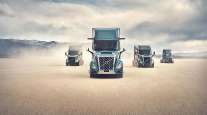Managing Editor, Features and Multimedia
Volvo Group CEO Martin Lundstedt Outlines Time of Transition for Trucking

[Stay on top of transportation news: Get TTNews in your inbox.]
ATLANTA — Volvo Group CEO Martin Lundstedt said the commercial vehicle industry has entered a time of transition with the rise of electric-powered trucks, automated driving technology and connected vehicles.
But even as those trends begin to take hold, the diesel engine and other well-established technologies still have a long road ahead of them, and drivers will remain essential to the trucking industry, he added.
Lundstedt made the remarks at the Heavy Duty Manufacturers Association’s luncheon and briefing on Oct. 29, held in conjunction with the 2019 North American Commercial Vehicle Show.
Volvo Group is the parent of Volvo Trucks and Mack Trucks.
Despite Volvo Group’s investment in emerging technologies, Lundstedt said a large proportion of the company’s research and development will focus on further refining commercial vehicle systems that are common today.
“[Internal combustion engine] technology is here to stay for many, many years to come,” he said, while also citing other existing vehicle systems such as transmissions, axles, steering, braking, aerodynamics and active safety. “A lot of it will persist and remain.”
“When we look at our R&D portfolio, yes, we are investing heavily into the new technologies, but equally heavily into what we call the well-known technologies,” Lundstedt said. “And that is not boring, it’s fun. There are a lot of things to be done in those areas as well.”
Looking toward the future, global population growth and the expansion of e-commerce will fuel greater demand for transportation, along with the need for heavy infrastructure investment, Lundstedt said.
At the same time, new technologies will create opportunities for efficiency and productivity gains.
One of those technologies, battery-electric vehicles, will be deployed in three phases, Lundstedt projected.
While early adoption has centered on image-driven customers, the next phase — elevated adoption — will begin when the technology becomes financially viable in specific segments and markets.
Those viable business cases are beginning to appear in applications with high vehicle utilization and repetitive freight flows, and in areas with strong clean-air regulations and government incentives, Lundstedt said.
“In certain regions and countries, I think we will see a ramp-up,” he said. He pointed to upcoming greenhouse gas regulations in North America and other regions, “where we need to push certain volumes to have the right balance.”
Broad adoption of electric vehicles will occur when financial viability becomes widespread, Lundstedt said. “This is a long journey.”
Today, Volvo Trucks North America is demonstrating the capabilities of battery-electric trucks in Southern California port drayage operations through the Volvo LIGHTS project, which stands for low-impact green heavy transport solutions. That project was funded by a $45 million investment by Volvo and a $45 million grant funded by the California Air Resources Board.
Meanwhile, Mack Trucks is preparing to deploy a battery-electric refuse truck with the City of New York Department of Sanitation.
Another megatrend is the emergence of autonomous transportation, which Lundstedt predicted will come to industrial vehicles before passenger cars. That’s because the commercial vehicle industry includes many applications where the vehicle operates in confined areas, such as ports, terminals, quarries and mines, that also have repetitive freight flows.
Volvo has introduced Vera, an autonomous tractor with no cab that is designed to haul trailers at relatively low speeds along specific routes in industrial areas.
The truck maker has partnered with logistics company DFDS to deploy Vera to transport freight between a logistics center and a port terminal in Gothenburg, Sweden.
But as automated driving technology advances, the truck driver remains paramount.
“The Volvo Group and all of our brands and all of our engineers around the globe will continue to have drivers as the main priority, because when we listen to our customers, we know that the main asset is the drivers,” Lundstedt said.
The expansion of digitalization in the transportation industry also holds great potential, he said.
Volvo Group now has more than 1 million connected assets in the world, including trucks, buses and machines.
“We are gathering an enormous amount of data when it comes to speed, fuel, component status, different kinds of behavior patterns,” Lundstedt said.
With all of that data now available, the focus has turned to analyzing it to provide actionable intelligence, he added.
Want more news? Listen to today's daily briefing:





